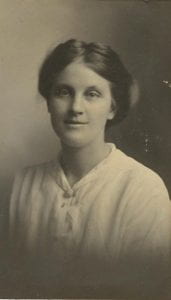
This biography was provided by Uriti’s son, James Torrie
Uriti (“Riti”) Strack was born at Pleasant Point in 1891 and grew up in Hawera. Her father, Conrad Anthony Strack was a schoolteacher of German heritage. Although he and his wife never owed their own house, they raised four sons and two daughters who all went on to finish university. Conrad sadly died only one year after retiring.
Riti was a student teacher from 1912 until 1916 when her father sent her to Australia to complete a home science degree. Two tragic deaths determined the course of her life—her younger brother was killed at Passchendaele and her fiancé Herbert Hogben also died in France in 1917. However, Herbert left a legacy to his widow, enabling Riti to enrol at the University of Otago in 1920, and she went on to graduate from medical school in 1925.
Riti’s first appointment as a doctor was at Mangonui Hospital (which later moved to Kaitaia) where she met her future husband Ralph Torrie, the county engineer. Riti and Ralph were married in 1926, and Riti started her own private practice under the name Strack Torrie.
Riti had a steely resolve, which was needed in those difficult times when the Depression brought poverty to the community. She never charged her patients for services, and would instead accept kits of kumara, braces of pheasants, or other donations. In 1937, a Government fee of seven and six for service became available, and this was all she accepted.
Riti regularly made arduous trips over the rough unsealed roads of Northland in her Morris 10 to visit patients who had no means of transport. She rode on horseback five miles from Ahipara to Reef Point to catheterize a man suffering prostate problems. When her friend suffered a tragic riding accident at the other end of ninety-mile beach, her husband Ralph drove her sixty miles up the beach to Te Paki Station in the darkness.
With no antibiotics available at the time, no time could be lost in cleaning and closing a wound. One of her son James’ earliest memories was stepping on an axe and slicing his foot near in half. He was quickly rushed to the kitchen and held down by his father while Riti calmly stitched together the injury without anaesthetic.
Many patients were in need of obstetric care and for twenty years many, if not most, of the
births in Kaitaia and surrounds were conducted and recorded in Riti’s obstetric diary. In many cases, the mothers became Riti’s lifelong friends.
Riti was 37 when her first son was born, and 44 when her youngest son completed her family. Her husband went to war in 1942, and as before she ran her life with great commitment to her profession and her family. In 1945, the family moved from Kaitaia to Otahuhu when Riti practiced for another twenty years, until the age of 75. Many patients came to see her, both for medical and personal advice. To her family and her patients, Riti was the personification of an iron fist in a velvet glove—she had a quiet composed way of persuading others to take her advice or do as she suggested.
In the 1950s, now aged in her sixties, Riti still had boundless energy. Friday evenings at 9pm, after surgery, she would bundle the family into the car for the three-hour journey to the holiday bach, returning by 10pm Sunday. Earlier in her life she had made several voyages to Britain on cargo freighters as the ships doctor, and she every winter until she was 94 years old, she travelled to England to spend the summer with her son. Riti passed away in 1987 at the age of 96.
